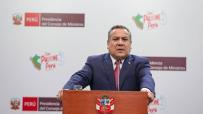
Rising gold prices on the international market and growing demand have led in recent years to the expansion of illegal mining in Latin America, but mainly in the Amazon areas near the borders of Peru, Colombia and Brazil. Illegal gold circulates between the countries without much control by their governments. Meanwhile, authorities are increasingly registering a greater presence of large drug trafficking groups in the business of extracting gold in the world's largest tropical rainforest.
For this investigation, a team from OjoPublico's Cross-Border Network spoke with sources directly related to gold mining and organized crime in these countries, including police officers, investigators, prosecutors, national government authorities, academic researchers and members of civil society working in these areas. They all concluded that organized crime is crossing borders in cooperation with —and sometimes violently dominating— local actors to increase and diversify the groups' illegal businesses.
The new hotspots of illegal mining in the Amazon are concentrated in rivers: the Nanay (Peru), Juruá (Brazil) and, on both sides of the border, the Putumayo (Peru-Colombia), Cotuhé (Peru-Colombia), Madre de Dios (Peru-Bolivia) and Puré-Purué (Colombia-Brazil). Part of this gold ends up in the capitals of these countries, according official production figures, to be laundered into the formal chain and exported. However, another part, as seizures reveal, crosses the borders illegally.
"If in one place there is intense surveillance, with operations, [the miners] migrate to other regions [of the Amazon]. And those who launder this gold try to take it to where it is easier to legalize. For example, if there is a possibility that gold extracted in Brazil will be more easily legalized in neighboring countries, naturally criminals in regions close to the border will take it there, and vice versa," Humberto Freire, director of the Amazon and Environment department of the Brazilian Federal Police, who has been working since 2023 monitoring illegal activities and promoting greater cooperation between police authorities in the Amazon countries, told OjoPúblico.
Despite the advance of illegal mining in the Amazon, exports of gold with high percentage of purity have increased in the Andean Amazon countries. As part of the Amazon Dirty Gold series, OjoPúblico's Cross-Border Investigative Network partners identified that the production figures declared by Peru, Colombia, Ecuador, Bolivia and Brazil are lower than the volumes of gold that are ultimately exported. The investigation reveals that at least 3,300 metric tons of gold of unknown origin were exported in the last decade.
Today, illegally mined gold is three times more profitable than cocaine. This is according to a 2023 study by Brazil's Igarapé Institute, which compiles information from various sources on the subject.

EXPANSION. One of the most critical points of illegal mining is Madre de Dios, where police operations are no longer enough to stop the extraction.
Photo: OjoPúblico / Aldaír Mejía
It is not known exactly how much of this total is extracted from the Amazon, but experts say the rainforest supplies most of this uncontrolled extraction because of the high purity of Amazon gold. Weak law enforcement and the high price of gold —which has risen 56% in the last five years— increase the profitability of the illegal business.
In Colombia, Bolivia, Ecuador and Peru there is no detailed traceability of the actors involved in the commercialization of gold to certify its origin in a transparent manner. In the case of Brazil, until 2023, a declaration was accepted based on the presumption of good faith by the first seller in the chain. This person is usually associated with a cooperative with a permit to sell or extract the mineral.
However, Brazil changed its legislation in 2023 and now the Brazilian Central Bank no longer assumes good faith in commercial transactions or for the legal origin of gold. The national tax authority now requires all documentation on the trading of related persons and companies to be registered online, in order to improve traceability and prevent gold laundering. The impact of the new guidelines is still unclear.
Brazilians arrive in Peru
In addition to the ease of legalizing illegal gold, there is a high profit to be made from extraction, which, according to estimates by researcher Rodrigo Chagas, of the Brazilian Public Security Forum, can be up to eight times the amount invested in a year.
Illegal gold mining techniques in the Amazon are no longer largely artisanal and now use more sophisticated tools. They use Internet communication, solar energy, new generations of engines and more powerful mechanical equipment to remove soil and riverbeds, increasing the productivity of the operations.
"Setting up illegal mining is a resource-intensive business these days. The [biggest] dredges can cost up to 1.5 million USD, as well as the logistics to supply the miners with food and airstrips in some places. There are drug gangs that take the money earned from drug trafficking in the Amazon and reinvest it in illegal mining, because the profit increases after a while and it is easier to launder the money by selling the gold," Rodrigo Chagas explains.
In Colombia, Bolivia, Ecuador, and Peru, there is no detailed traceability of the different actors involved in the commercialization of gold."
Brazilian criminal organizations —as OjoPúblico has revealed in other reports— have expanded into various territories in the Peruvian Amazon. This is the case, for example, of the Red Command, which has begun operating in two areas: on the Peruvian border with Acre and along the Javari River, where it has gone from being a buyer of coca to a partner in the planting and refining of the leaf.
Brazilian authorities working in the states of Acre and Amazonas, bordering the Peruvian departments of Loreto, Ucayali and Madre de Dios, claim that there are already groups linked to the Red Command also operating in the new illegal mining hotspots in the Peruvian Amazon.
In the Nanay River basin, there are areas of the river where these groups are already controlling the entry and exit of people linked to drug trafficking in the area.
"First they enter as guards to protect these illegal operations and then they take control of the miners who are operating there. It is a new dynamic, from more recent mining areas, different from what is happening in Madre de Dios, which is a more consolidated mining area," details Martín Arana, a researcher with the Foundation for Conservation and Sustainable Development (FCDS), an organization that works in Colombia and Peru.

UNLAWFUL. In the Nanay River basin, there are areas where these groups are already controlling the entry and exit of people linked to drug trafficking in the area.
Photo: United for the forests / FCDS Perú
The latest monitoring report on coca crops in Peru shows an increase in these plantations in Madre de Dios, one of the regions with the largest enclave of illegal mining. "Part of these new crops are in the mining area. It is a clear indicator that this relationship is also being established there, or at least that there is an overlap of illicit activities. It is still not clear at what level these groups are in the mining business, but at least they are exercising territorial control," says Arana.
The drug transit route, whether to areas outside the Amazon or across the border, also ends up being used by illegal mining. "It's the same logistical corridor, and that's why the group that dominates the route usually has closer relations with illegal mining," Arana said.
On the border between Peru and Brazil's Acre state, the Red Command and groups linked to the Rio de Janeiro-based faction control most of the area, according to the Acre Public Ministry.
"We see more and more co-optation and growth of factions in border areas where coca is produced. The Ucayali River region has seen a huge increase in coca production, and we are concerned that there is an alliance between Peruvians and Brazilians, just as we are concerned that Comando Vermelho is getting into mining in Madre de Dios. The Pucallpa penitentiary already has many members of the Brazilian faction in jail," explains Bernardo Albano, a prosecutor from the Public Prosecutor's Office in Acre.
Colombians advance over the borders
Illegal mining is taking over much of the Peruvian Amazon and is not limited to the area near the border with Brazil. A 2023 report by the Foundation for Conservation and Sustainable Development (FCDS-Peru) states that at least 32 districts in five Amazon regions are affected by the activity.
The Putumayo and Cotuhé river basins, on the border between Peru and Colombia, are large areas of drug production and trafficking and illegal mining, where different groups fight for control of these activities.
In Colombia's border regions with Brazil and Peru —following the peace agreement signed with the FARC in 2016— dissident groups, such as Comandos de la Frontera or Frente Carolina Ramírez (known as Grupos Armados Organizados Residuales, GAOR), have set up shop, disputing territories with the Clan del Golfo, one of Colombia's largest drug trafficking organizations.
OjoPúblico has identified that armed groups of Colombian origin dedicated to drug production and trafficking, and illegal mining operate on the Peruvian side of the Putumayo River border.

NEGLECT. At the Peruvian border area of Putumayo, neglect and precariousness are evident in places such as the police stations.
Photo: OjoPúblico
A Colombian researcher at a nonprofit organization doing field work on his country's borders with Peru and Brazil —who asked not to be identified for security reasons— says FARC dissidents are much closer to the border than they have been in the past. "There is an increase in new groups, and their tactic is to say they are from group X when in reality they are from group Y," the researcher said.
Illegal mining has established itself as the most profitable illicit activity for Colombia's armed groups, complementing drug trafficking activities. One of the documents accessed by OjoPúblico mentions that in several regions of the country, illegal mining represents more than 50% of the total economy of criminal groups.
Mining and organized crime in the Brazilian Amazon
In 2021, a FARC dissident group called the Miller Perdono Commission was extorting money in exchange for protecting miners on the Brazilian side of the Purué River, on the border with Colombia.
Mining in this region of Brazil has skyrocketed since 2019, taking advantage of the dismantling of inspections and environmental crime enforcement forces in the Amazon carried out by the government of Jair Bolsonaro (2019-2022).
A group of Brazilian miners backed by large investors left from other parts of the Amazon for the Brazilian side of the Purué River in order to extract gold. In the absence of control, the flow of large dredges grew, attracting the attention of FARC dissidents already operating on the Colombian side. The Colombians lowered the river by charging extortions in exchange for security to operate and navigate the area, according to the Federal Police.
The Brazilian miners requested the country's security forces to remove the Colombians from Purué. An operation by the Brazilian Army together with the Federal Police managed to expel the FARC dissidents, who exercised control of the territory for some months in 2021. The Army has not publicly confirmed the operation and the Federal Police issued a brief statement on the matter.
The seizure of the Purué River by criminal groups from Colombia also exposed the lack of state control in the area, which corresponds to the Caquetá (Colombia)-Japurá (Brazil) watershed, a major Colombian-produced drug trafficking route for Brazil's largest criminal factions such as the Red Command (Comando Vermelho) and the First Capital Command (Primeiro Comando da Capital - PCC).
The new hotspots of illegal mining in the Amazon are concentrated in rivers such as the Nanay (Peru), Putumayo (Peru-Colombia), and Puré-Purué (Colombia-Brazil)."
The Purué riverbed —in Brazil and Colombia— continues to be destroyed by illegal mining, but now under the domination of Brazilian mining groups, while in Colombia they remain under the supervision of Colombian armed groups.
In 2023, with the change of government in the country, Brazil resumed anti-mining operations. In May of that year, 29 dredges were destroyed. Then, in December, as part of the first binational operation against mining, armed forces from both countries burned another 19 dredges.
The destruction of the machinery, however, does not mean the end of illegal gold mining on the border. During a flight over of the region in 2022, and with the help of satellite imagery, the nonprofit organization Amazon Conservation Team estimated that at that time there were more than 150 dredges operating on the Purué River. That was a much larger number than the dredges destroyed in 2023, suggesting that many of the miners managed to hide their rafts from security forces.
"As long as there is no permanent presence of law enforcement agencies in this region, it will be a game of cat and mouse. In practically all the major waterways of the Brazilian Amazon there is gold mining in some part of them. There are national and foreign criminal organizations involved in this practice, such as the Red Command, the PCC and Colombian groups. Rivers are used to transport coca production in Colombia and Peru, but also to transport machinery and other work tools. The logistics of one crime favor the establishment of another. A criminal group can pay a drug supplier in another country with the gold it has earned in a mining operation in the same region, for example," says André Luiz Cunha, a prosecutor for the Western Amazon of Brazil's Federal Public Prosecutor's Office, who specializes in the fight against illegal mining.
A survey conducted in 2023 by the Brazilian Public Security Forum shows that criminal factions are present in a third of municipalities in the Brazilian Amazon. The Red Command and the PCC are present in almost all of these municipalities, in an operation that began in 2016 and continues to expand, making the rainforest the most violent region in Brazil today. Border territories in Amazonas and Acre have been the scene of disputes between these organized criminal groups.
Ease of laundering, transportation and money laundering
The professionalization of organized crime is translating into the professionalization of illegal mining. A report by the Organization of American States (OAS) draws attention to the synergy between the two activities. International factions such as the Red Command and the PCC, or the Colombian GAOR, have extensive experience in money laundering and how to evade the scrutiny of security forces, in addition to having trade routes and logistics to access the inputs that guarantee the operation.
Unlike drugs, laundering the profits generated by illegal gold requires only two steps. First, it is necessary to forge or obtain papers that mention a legal origin. Then, the profits from its sale must be disguised in some legalized operation, such as supermarkets, transport companies and gas stations.
The OAS report maps the 16 ways in which illegal gold is laundered in Latin America, a crime described by Interpol as one of the most lucrative in the world. Concern over the advance of this activity in the subcontinent, which has the highest percentage of illegal gold mining in the world, led the international organization to create a team focused exclusively on helping national authorities investigate money laundering linked to illegal mining in Latin America.

SUSPICIOUS. In Peru, there are cases of gold that is exported to the United Arab Emirates and Switzerland without certifying its legal origin.
Photo: Perú Attorney General's Office
In Peru, Colombia and Brazil, gold is easily transported to capital cities such as Lima, Bogota, Manaus and São Paulo, where it reaches the legal market. From these cities, much of the gold is exported mainly to the United States, Canada, the United Arab Emirates, India and Switzerland, OjoPúblico's research reveals.
Melina Risso, research director of the Igarapé Institute, has been studying the issue for several years and emphasizes the ease with which illegal economies can form alliances in the Amazon.
"Gold is a financial asset that is easy to transport and with a fragile production chain in terms of traceability, which allows illegal gold to easily enter the legal economy, at the same time that money from other activities enters this chain. We have today a poorly controlled market, with few rules, of a very profitable material that is extracted in a vast territory: the conditions for a perfect storm," he tells OjoPúblico.
The porosity of borders combined with the internationalization of criminal groups invested in illegal mining has led to some joint, albeit timid, institutional responses. In April, the International Police Cooperation Center, the fruit of a memorandum signed between eight countries of the Amazon Cooperation Treaty Organization (ACTO) in August 2023, will begin operating in Manaus, in the Brazilian Amazon.
The center will work with law enforcement authorities from ACTO countries, who will exchange information on criminal dynamics in the Amazon.
Also for the first time, the Brazilian Federal Police is creating an inventory of gold in the Amazon. The initiative aims to catalog the "DNA" of gold from different regions, which would help to demonstrate the origin of the circulation of gold in and out of the Amazon.
"The international community, and not just Amazonian countries, needs agreements for greater transparency and traceability in the global gold trade chain. The ability of criminal groups to adapt is often faster than that of the state. This more global process must be as clear or rigorous as it is for diamonds. Otherwise, these territories will remain vulnerable to an international demand that is not transparent," says Martin Arana.
 Tienes reportajes guardados
Tienes reportajes guardados















